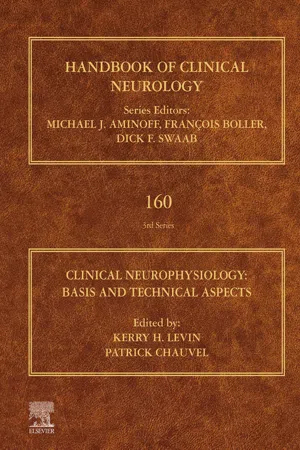Biological Sciences
Autonomic Nervous System
The autonomic nervous system is a division of the peripheral nervous system that regulates involuntary bodily functions, such as heart rate, digestion, and respiratory rate. It consists of two main branches: the sympathetic nervous system, which prepares the body for action, and the parasympathetic nervous system, which helps the body rest and digest. These two branches work in opposition to maintain homeostasis in the body.
Written by Perlego with AI-assistance
Related key terms
5 Key excerpts on "Autonomic Nervous System"
- eBook - ePub
- Jim E. Riviere, Mark G. Papich(Authors)
- 2017(Publication Date)
- Wiley-Blackwell(Publisher)
Section 2 Drugs Acting on the Autonomic Nervous SystemPassage contains an image
Joshua A. Rowe, Rose M. McMurphy, Barbara J. Lutjemeier, and Michael J. Kenney6 Introduction to the Autonomic Nervous System and Autonomic Pharmacology
Introduction
The Autonomic Nervous System (ANS) includes afferent, central, and efferent components. The efferent component is the general visceral efferent (GVE) system and is subdivided into two primary branches, the sympathetic nervous system (SNS) and the parasympathetic nervous system (PSNS). More recently, the enteric nervous system is considered a functional component. The ANS plays a critical role in regulating processes required for maintaining physiological homeostasis and responding to acute stressors. Numerous physiological functions are regulated by the ANS including, but not limited to: regulation of heart rate and cardiac contractility; visceral and cutaneous blood flow distribution; gastrointestinal motility and digestion; and urogenital processes. It is virtually impossible to consider physiological regulation without integrating the roles of sympathetic and parasympathetic neural mechanisms into a functional overview, as summarized in the Primer on the Autonomic Nervous System (Hamill and Shapiro, 2004):The Autonomic Nervous System (ANS) is structurally and functionally positioned to interface between the internal and external milieu, coordinating bodily functions to ensure homeostasis (cardiovascular and respiratory control, thermal regulation, gastrointestinal motility, urinary and bowel excretory functions, reproduction, and metabolic and endocrine physiology), and adaptive responses to stress (flight or fight response). Thus, the ANS has the daunting task of ensuring the survival and the procreation of the species. - Derrick Lonsdale, Chandler Marrs(Authors)
- 2017(Publication Date)
- Academic Press(Publisher)
1 it is difficult for the physician to diagnose a dysautonomic syndrome without an appreciation of the functional adaptations of the ANS to “stressors.” These stressors, whether mediated by outside sources, such as exposures to chemical or dietary toxicants, illness, and life in general, or by aberrant internal adaptations, produce characteristic patterns of autonomic disorder based upon where the triggering event attacks. Understanding these patterns will help the clinician immensely. No attempt will be made to deal with ANS in full since that information is readily available in any textbook on physiology. We do, however, want to provide an overview and emphasize concepts that will aid in the recognition of disordered autonomic function, particularly as it relates to thiamine deficiency.The Autonomic Nervous System: General Arrangement and Function
The central nervous system includes the brain and spinal cord and the peripheral nervous system, within which is the somatic branch responsible for voluntary movements. The ANS activates the involuntary responses of vital organs and organismal homeostasis. It is therefore responsible for maintaining life. The ANS operates largely at the border between central and peripheral nervous system functions. The lower brain organizes adaptation to internal and external stimuli while it relies on the cortical brain to interpret and guide further accommodations. It is important to emphasize that if either aspect of communication is impaired, autonomic regulation will be impacted. The autonomic system can be divided into three branches: sympathetic, parasympathetic, and enteric.Sympathetic and Parasympathetic Divisions
Also known as the vegetative, visceral, or involuntary nervous system, the ANS controls the activities of heart rate, respiration, digestion, blood flow, glands, and all smooth muscles. Structurally and functionally, it is divided into two tracts that control activation and deactivation of automatic and reflexive functions in a complementary fashion. The sympathetic tract, which is largely responsible for action coordination, innervates viscera through the splanchnic nerves, exiting the spinal cord from the thoracic and lumbar areas. The parasympathetic tract, responsible for tamping down the excitatory influence of the sympathetic branch, innervates through the cranial, sacral, and vagus nerves. Central control of these functions originates from the hypothalamus and the brainstem, the nuclei of which integrate information sent from the central and peripheral nervous systems. This adjusts autonomic function accordingly. Fig. 2.1- Laurie K. McCorry, Martin M. Zdanowicz, Cynthia Yvon Gonnella(Authors)
- 2018(Publication Date)
- Routledge(Publisher)
chapter fourteen The Autonomic Nervous System Study objectives • Explain how various regions of the central nervous system regulate Autonomic Nervous System function • Explain how autonomic reflexes contribute to homeostasis • Describe how the neuroeffector junction in the Autonomic Nervous System differs from that of a neuron-to-neuron synapse • Compare and contrast the anatomical features of the sympathetic and parasympathetic systems • For each neurotransmitter in the Autonomic Nervous System, list the neurons that release them and the type and location of receptors that bind with them • Describe the mechanism by which neurotransmitters are removed • Distinguish between cholinergic and adrenergic receptors • Describe the overall and specific functions of the sympathetic system • Describe the overall and specific functions of the parasympathetic system • Explain how the effects of catecholamines differ from those of direct sympathetic stimulationThe Autonomic Nervous System (ANS) is also known as the visceral or involuntary nervous system. It functions without conscious, voluntary control. Because it innervates cardiac muscle, smooth muscle, and various endocrine and exocrine glands, this nervous system influences the activity of most of the organ systems in the body. Therefore, it is evident that the ANS makes a significant contribution to homeostasis. The regulation of blood pressure, gastrointestinal responses to food, contraction of the urinary bladder, focusing of the eyes and thermoregulation are just a few of the many homeostatic functions regulated by the ANS. Several distinguishing features of the ANS and the somatic nervous system, which innervates skeletal muscle, are summarized in Table 14.1- eBook - ePub
Clinical Neurophysiology: Basis and Technical Aspects
Handbook of Clinical Neurology Series
- (Author)
- 2019(Publication Date)
- Elsevier(Publisher)
Section VII Autonomic Nervous System: Basic and technical aspectsPassage contains an image
Chapter 27Basics of Autonomic Nervous System function
Christopher H. Gibbons*Department of Neurology, Beth Israel Deaconess Medical Center, Harvard Medical School, Boston, MA, United States* Correspondence to: Christopher H. Gibbons M.D., Center for Autonomic and Peripheral Nerve Disorders, Department of Neurology, Beth Israel Deaconess Medical Center, 1 Deaconess Road, Boston, MA, 02215, United States. Tel: + 1-617-632-8454, Fax: + 1-617-632-0852 email address: [email protected]Abstract
The Autonomic Nervous System has widespread innervation to nearly every organ system in the body. In order to understand the basics of autonomic function, knowledge of the neuroanatomy of the Autonomic Nervous System is necessary. Frequently considered to control the “fight or flight” and “rest and digest” functions, the Autonomic Nervous System has an intricate network of connections to finely tune the systemic response to nearly any situation. Although traditionally considered two discrete systems (sympathetic and parasympathetic), the enteric nervous system is now considered a third component of the Autonomic Nervous System. This chapter reviews the background of the neuroanatomical distribution of the Autonomic Nervous System in order to facilitate understanding the basics of autonomic function.Keywords
Autonomic Nervous System; Autonomic neuroanatomy; Parasympathetic nervous system; Sympathetic nervous system; Enteric nervous systemIntroduction
The Autonomic Nervous System is wide ranging and extends to most organ systems within the body. Therefore, the study of autonomic function is often tied to a particular end organ of interest. The anatomy of these systems will be described from the central to the peripheral nervous system. The functional autonomic outputs, defined by the sympathetic, parasympathetic, or enteric systems, provide a tightly integrated combination of sympathetic and parasympathetic control. Therefore the basics of autonomic function will be described by using the anatomy of the Autonomic Nervous System as a canvas to discuss the roles of the parasympathetic and sympathetic systems. - James J Blascovich, Eric Vanman, Wendy Berry Mendes, Sally Dickerson(Authors)
- 2011(Publication Date)
- SAGE Publications Ltd(Publisher)
2Autonomic Nervous System: Obtaining, quantifying, and interpreting peripheral physiological responses
In this chapter we explore the primary regulatory system of the body – the Autonomic Nervous System (ANS) – which functions to mobilize energy and deliver oxygenated-blood to the body. Changes in the ANS can result from such quotidian events as sleeping and waking, postural changes, and physical movement. More interestingly for social psychologists, ANS responses can change as a function of shifts in mental states involving emotional, attentional, motivational, and stress-related processes. Here, we review some of the more commonly used measures that can be obtained relatively non-invasively. We describe the process of obtaining ANS responses including technological requirements for lab and field experiments, and the specifics of obtaining, scoring, quantifying, analyzing, and interpreting ANS responses. We end each subsection by reviewing social psychological literature that has effectively used these measures.Getting Started
Like riding a bike for the first time, getting started with a psychophysiology lab might be the most difficult part. Many decisions must be made regarding how to set up a laboratory, what equipment to purchase, what type of space is needed, programming versus purchasing software to edit and score data, and more. This section describes some of the choices that need to be made and provides information to assist in making these choices. Also, it is important to point out that a “best-case scenario” is presented and there will be occasions when one will not be able to control all the elements in a dedicated space. In this case, it is important to know what could affect recordings and to faithfully keep track of those factors as possible extraneous influences.The question of what type of equipment one should obtain needs to be guided by what types of research questions will be explored. Researchers should not find themselves in the position of developing research questions around the equipment they have, but rather, the research questions should dictate the physiological equipment they obtain. Here, general guidelines for setting up a lab are described, delaying discussion of specific measures until the following section.
Learn about this page
Index pages curate the most relevant extracts from our library of academic textbooks. They’ve been created using an in-house natural language model (NLM), each adding context and meaning to key research topics.




